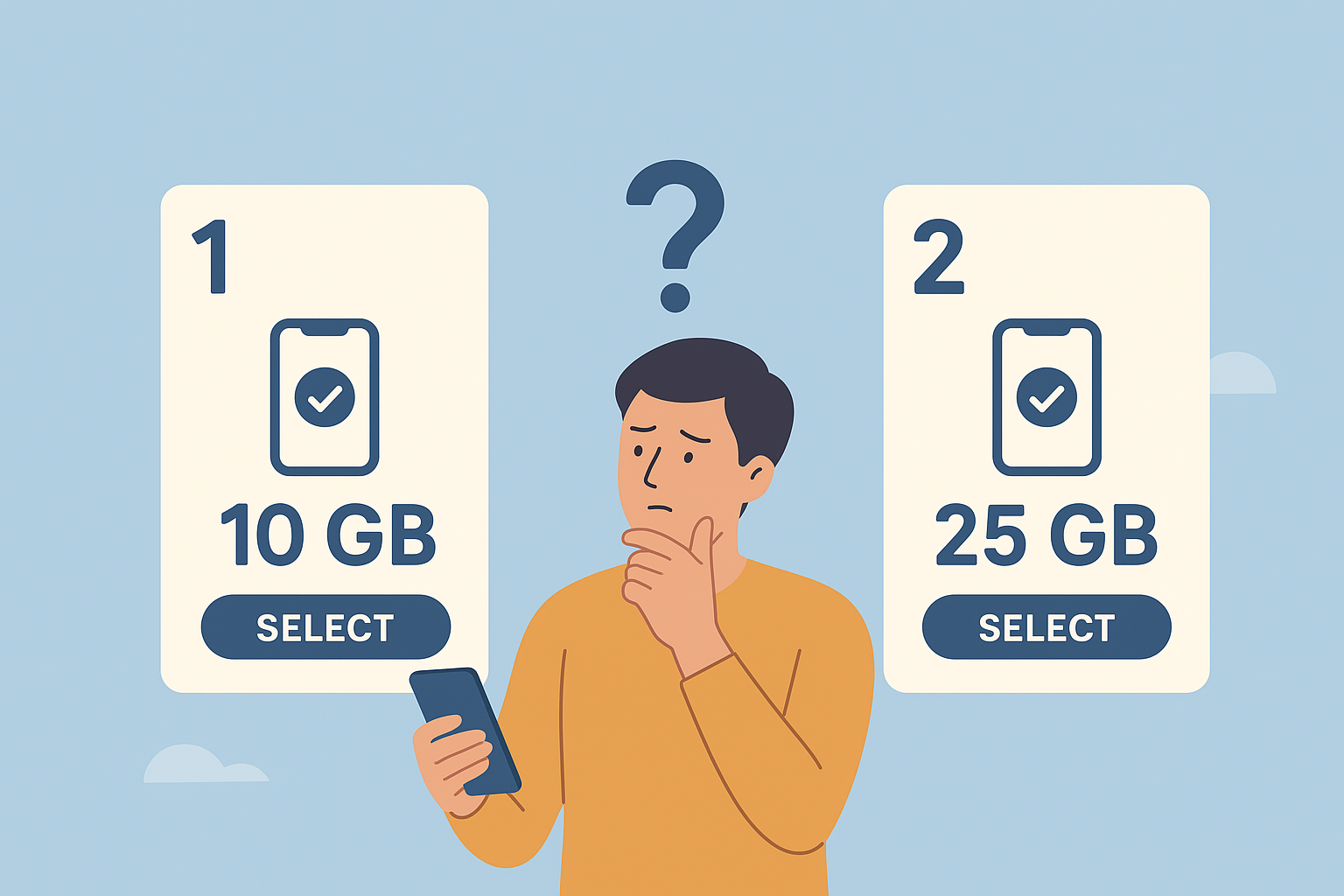How to Compare Mobile Plans Before Switching

Switching phone plans might sound simple — until you realize how many options there are. From prepaid to postpaid, unlimited to shared, and carriers promising “best coverage” everywhere, it’s easy to get overwhelmed. Many users switch because of high bills or poor service, but they end up with the same issues under a new name.
Before you make the move, it’s important to understand exactly what each plan offers, how it matches your lifestyle, and what hidden factors can affect your experience. Whether you’re upgrading your phone, seeking better network reliability, or trying to save money, comparing mobile plans the right way ensures your next choice is the best one yet.
This detailed guide will walk you through how to compare mobile plans before switching, what to look for in the fine print, and how to find the best deal for your data, budget, and habits.
Why It’s Important to Compare Mobile Plans
Many people switch carriers based solely on price or promotional offers. While saving money is great, a plan that doesn’t meet your needs can lead to frustration — like slow internet speeds, poor coverage, or unexpected fees.
Taking the time to compare plans gives you a clearer picture of what you’re really paying for. It allows you to:
Avoid paying for data or minutes you don’t use
Find networks with better coverage in your area
Prevent bill shock from hidden fees and taxes
Choose plans that support features you actually need (like hotspot data or roaming)
Ultimately, comparing before switching helps you make an informed decision — one that saves you money and gives you the convenience and performance you expect from your phone service.
Step 1: Know Your Current Usage
Before you can find a better deal, you need to understand your current habits. Most people overestimate how much data they actually use. By analyzing your recent bills or checking your carrier’s app, you can see exactly how much data, talk time, and text you consume each month.
If you mostly use Wi-Fi at home or work, you may not need an unlimited plan. On the other hand, if you stream videos or use GPS frequently, data limits could become an issue.
Here’s what to review before comparing:
Average monthly data use: Check your history for 3–6 months.
Talk and text frequency: Do you still make many calls, or rely on messaging apps?
Travel habits: Do you need international coverage or roaming?
Extra features: Do you use tethering or mobile hotspot?
Understanding your real usage helps you focus on plans that match your behavior — not just what sounds good on paper.
Step 2: Compare Data Options (Unlimited Isn’t Always Best)
Data plans are the heart of most mobile services, and this is where things get confusing. Carriers throw around terms like “unlimited,” “priority data,” and “high-speed cap,” but the truth lies in the details.
Unlimited plans sound appealing, but most come with data deprioritization — meaning your speeds slow down once you hit a certain threshold or during busy hours. If you use less than 10 GB a month, you might save significantly by choosing a smaller, capped plan.
Prepaid plans are great for users who want control and flexibility. Since you pay upfront, there are no surprise bills or credit checks, and you can change plans anytime.
When comparing data options, pay attention to:
The amount of high-speed data before throttling begins
Whether hotspot use counts toward your total
If data rollover is offered for unused GBs
The availability of 5G in your area
If you’re unsure, start small — you can always upgrade later if your usage grows.
Step 3: Evaluate Network Coverage and Reliability
Even the most generous data plan means nothing if you can’t get a reliable signal. Network coverage is the foundation of your mobile experience, and it varies widely by location.
Start by checking coverage maps provided by major carriers, but don’t stop there. Real-world performance matters more than marketing maps. Ask family, friends, or coworkers which network works best in your neighborhood, workplace, and commute route.
Look for reviews and reports on:
Signal strength and data speed in your area
Dropped call rates and 5G availability
Performance indoors and in rural zones
Step 4: Understand Hidden Fees and Taxes
Many users switch plans thinking they’re saving money, only to discover their monthly bill is higher than expected. Why? Hidden fees and surcharges.
Carriers often advertise a “starting price” that excludes taxes and administrative costs. These can add $5–$20 per month, depending on your location and plan type.
Be on the lookout for:
Activation or setup fees
SIM or eSIM charges
Over-limit data fees
Early termination costs
Administrative or recovery surcharges
When comparing options, always ask for the total monthly cost after fees and taxes. Prepaid providers are often more transparent because their pricing is all-inclusive — what you see is what you pay.
Step 5: Consider Customer Service and Support
When everything’s working fine, support might not cross your mind. But when you run into a billing issue, SIM problem, or coverage glitch, you’ll be glad to have responsive customer service.
Evaluate each carrier’s customer support reputation before switching.
Look for:
24/7 chat or phone assistance
U.S.-based or multilingual support teams
User-friendly mobile apps for self-service
Transparent cancellation or refund policies
Reading customer feedback can tell you what a company’s really like beyond the ads. Reliable support can save you time and stress — especially during emergencies.
Step 6: Compare Intro Offers and Long-Term Value
Everyone loves a good deal — but promotional offers can be deceiving. Many carriers lure new users with short-term discounts or free add-ons that expire quickly.
When evaluating promotions, ask these questions:
How long does the discount last?
Does the rate increase after a few months?
Are special perks (like streaming services) temporary?
Is the promo tied to auto-pay or a specific payment method?
Focus on long-term value, not short-term savings. Sometimes, the best plan isn’t the cheapest up front but the one that remains affordable and stable over time.
Step 7: Read Reviews and Compare Independent Ratings
Don’t just rely on carrier websites — check independent sources. Consumer reports, tech websites, and community forums often publish real-world comparisons that reveal how carriers perform in different regions.
When reading reviews, pay attention to:
Network performance tests (speed, reliability, coverage)
Customer satisfaction ratings
Pricing transparency and complaint frequency
This outside perspective can help you spot red flags or confirm which providers deliver on their promises. It’s an easy step that can save you from future headaches.
Step 8: Don’t Forget Device Compatibility
Bringing your own phone? Great — but not every device works with every carrier.
Before you switch, confirm that your phone supports the same network frequencies and technologies (4G LTE, 5G, VoLTE) as the carrier. Most carriers provide an online tool where you can enter your IMEI number to check compatibility.
Unlocked phones generally work on multiple networks, but it’s still worth confirming. If your phone isn’t compatible, you might need a software update or new SIM to get full performance.
Step 9: Make the Switch the Smart Way
Once you’ve compared and chosen your ideal plan, it’s time to make the switch. Doing this correctly ensures a seamless transition and prevents losing service or your phone number.
Follow these steps:
Unlock your current phone if tied to your old carrier.
Back up your data — including contacts, messages, and photos.
Request number transfer before canceling your old plan.
Activate your new SIM or eSIM and test coverage immediately.
Monitor your first bill to verify charges and features.
Switching carriers can usually be done in less than an hour — but doing it the right way saves days of frustration.
Find Internet By Zip Code
Compare Plans
Final Thoughts: Compare First, Switch Confidently
Switching phone plans doesn’t have to be stressful. The key is preparation — knowing your needs, understanding your options, and evaluating both cost and quality.
When you compare mobile plans carefully, you can save money, improve performance, and avoid the common traps of hidden fees or bad coverage. Take your time, review real experiences, and make sure the plan you choose aligns with how you actually use your phone.
Related Posts

Fri, Nov 14, 2025 5:38 PM
cheap internet plansFiber Internet - A Practical Look at Whether It’s Worth the Upgrade
Wondering if fiber internet is worth the upgrade? This in-depth guide explains fiber’s pros, cons, comparisons with other internet types, and how to choose the right speed for your home.

Thu, Nov 13, 2025 9:59 PM
SubscriptionA Simple Guide to Getting Faster Internet at Home
Learn practical ways to improve your chances of getting high-speed internet at home. From choosing the right plan to optimizing your router and troubleshooting slow speeds, this guide covers everything you need for a faster, more reliable connection.

Wed, Nov 12, 2025 9:59 PM
TechnologyMobile Data Usage Calculator: Find Out How Much Data You Really Need Each Month
Learn how to accurately estimate your monthly data needs with a mobile data usage calculator. Discover tips to reduce overages, track usage, and choose the perfect mobile plan.

Tue, Nov 11, 2025 10:01 PM
Broadband DealsHow to Reduce Lag While Playing Online Games
Lags during playing games can be a disruption. In fact, in some instances, they can determine the difference in ranking high and last on the scoreboard. Most definitely, online gaming is

Thu, Nov 6, 2025 9:33 PM
Internet BundlesWhy Internet Speed Can Make or Break Your Business
Discover why fast, reliable internet is essential for modern businesses. Learn how strong connectivity boosts sales, productivity, customer experience, and overall performance.